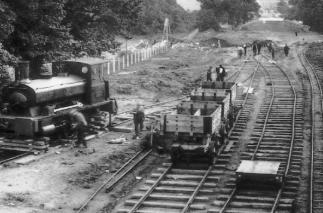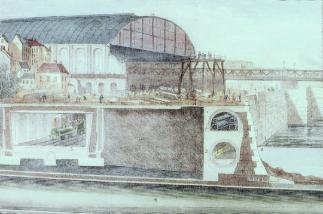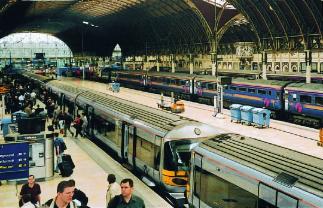1. Early days
In medieval times people mostly travelled by foot or horseback and any form of transportation was mainly for moving goods.
The first railroads were laid down in the seventeenth and eighteenth century for horse drawn trains of wagons in collieries and quarries. These 'hauling ways' initially had a surface of stone slabs or timber baulks which soon proved unsatisfactory as the loads carried inevitably grew heavier.
As the Industrial Revolution progressed, the idea was developed further by adding cast iron or wrought iron plates to reduce wear on the wooden baulks. This evolved further to iron edge rails enabling the use of flanged wheels for the first time.
By the time steam locomotives came on the scene, in the early nineteenth century, wrought iron rails and later steel rails were developed which were strong enough to support these heavy axle loads without assistance from longitudinal timbers.
In essence the track itself, together with its supports, had and still has the basic function of safely transmitting the loads and forces imposed by passing trains to the ground beneath.
Various other civil engineering skills were also involved in the construction of early railroads.
These included the building of bridges, tunnels and gravity walls as well as extensive earthworks and drainage.

FIG. 1. Early railroad construction.
From these earliest days, there was a need to balance the requirements and interests of the various engineering disciplines involved. As an example, rolling stock design has a considerable impact on the design and maintenance of the fixed infrastructure and there needs to be mutual appreciation and close co-operation between engineers if the best is to be achieved in all areas. This may sometimes require compromise in certain disciplines for the good of the whole.
2. Development and diversification
On the early railroads the Boards would invariably appoint an Engineer who would be responsible for all the engineering of the railroad parts, both moving and fixed. He would often also be involved in the actual day-to-day operating of the railroad. This had considerable advantage from a point of view of co-ordination.
As development of railroads progressed, inevitably individual engineers became more specialized and there tended to be a loss of the overall or generalist view.
It is the specific objective of the author of this guide to encourage a wider view in railroad engineering matters so that better appreciation of each other's engineering requirements and constraints is achieved.
3. The customer
In any consideration of the various engineering functions of a railroad, the needs and aspirations of the customer must always be kept in the forefront of the mind. The passenger's basic needs are to travel comfortably and to arrive safely at the destination reasonably on time. The freight customer needs confidence that his goods will be delivered safely and on time. Both want this service at a reasonable cost. All engineers and operators need to work together to achieve this objective.
This seems so obvious and basic that it hardly needs stating. However 'departmental' and local interests can and often do arise which can jeopardize this simple objective and engineers and managers at all levels need to be on their guard.
4 The operator
If the customer's needs must be kept paramount then it follows that the Operator's needs in satisfying the customer's needs are also very important.
Here however, there is room for maneuver. In satisfying the customer's basic needs, there is often more than one operational solution. In this case, it is incumbent on both the operators and the engineers involved to jointly consider all the valid options which are available. A good example of this is the consideration of carrying out week-end essential works either over a number of shorter possessions of the railroad or over one longer week-end.
The operator must also be able to deal with emergencies during periods of engineering work and contingency plans must be drawn up for this.

FIG. 2 Underground railroad construction at in the UK Blackfriars: 1871.
5 Overall planning
In constructing and maintaining any railroad system infrastructure, there always are many activities which are carried out in each of the engineering disciplines which overlap onto other disciplines/activities. This is inevitable.
Proper co-ordination and co-operation is necessary here. There are also, from time to time, items of work where there is considerable overlap or 'knock-on' effect. An example of this might be the requirement to renew a number of bridges on a certain line all of which carry signal cables or equipment which is nearing the end of life expectancy. Depending on relative costs in each area, an optimum program could be drawn up jointly which would keep overall costs and disruption to a minimum in the long term.
Similarly booking of long possessions to do work in one area might provide opportunities for other engineers to carry out other works at the same time, thus reducing expenditure overall. This type of co-operation is not always easy and does require a flexible attitude and acceptance sometimes of irksome restraints. However, maximum benefit of the whole must be the criterion.
6 Choice of route and level
In the earliest stages of planning of any railroad, choices have to be made relating to the best route, and which parts will need to be elevated or in tunnel. The route will be largely dictated by traffic demands and existing physical constraints, although in some instances alternatives might be available where engineering and cost variations should be compared.
In such cases, ground conditions and water levels as well as existing building foundations and services must all be taken into consideration.
Again the level of the railroad will be determined by existing physical constraints. It is essential, however, that all engineering implications are fully investigated and costed before any decision is made to construct a railroad, either underground or on elevated structure.
For underground construction, full allowance must be made for the 'full life' costs of escalators, ventilation/air conditioning, lighting and other services, additional tunneled accommodation for staff, fire protection and emergency exits etc. Disruption during the construction period of works in inner city areas is a factor that needs also to be taken into account when deciding whether or not to go underground.
Before adopting any form of elevated railroad, a careful consideration on environmental issues including visual impact and noise as well as dealing with emergencies at high level is needed. Although elevated railroads occupy less ground level space than surface railroads, the stations often cover more relative area because of the need for stairs, ramps and escalators etc.
From an engineering point of view, alignments should also be as smooth as possible without steep gradients or tight curves to reduce wear on both the rolling stock and the track and to keep power consumption to a minimum.
7 Required resources
For the satisfactory operation and maintenance of a railroad, certain basic resources are required, which can be grouped into human resources, fixed assets and mobile machinery. Inadequacy in any of these three sides of this fixed triangle will mean that good operation cannot be maintained, irrespective of the performance on the other sides.
Careful selection and adequate training of personnel at all levels is essential. On-going good relations with staff, both at National and local level must have a high priority. This requires constant attention at all levels of engineering management. As in any large organization, individuals need to feel that they are valued and that they have a positive part to play in the running of the whole enterprise.

FIG. 3 Concourse and roof at Paddington.
The following sections of this guide deal with the outline requirements of fixed assets and mobile machinery that are necessary to satisfactorily operate and maintain a railroad system. This relates to the various disciplines involved but it is vital to keep in mind that in all areas, adequate human resources are often the key to success or failure.
The intention of this guide is only to give a general engineering overview of all that is involved in designing, running and maintaining a railroad. Because of this, readers may require in certain areas to look deeper.
Prev. | Next
Top of Page | Article
Index